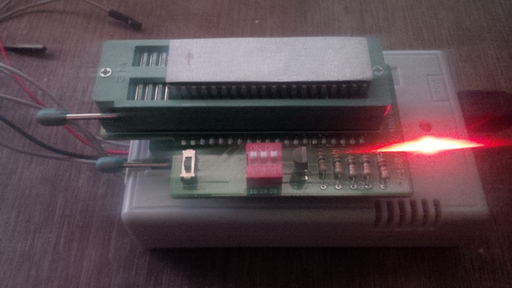Table of Contents
Shortnote
Using a low-cost TL866 Pro and 27C400 adapter, kickstart ROMs can be burnt in order to replace the Amiga chips. One reason to do this is to upgrade a classic Amiga to newer AmigaOS versions without having to patch the ROM at runtime via LoadModule, LoadResident or BlizKick which may require a reboot.
The tutorial offers some notes on the required hardware used and how to operate a TL866 Pro in order to burn two Amiga ROM chips with kickstart 3.1.4.
Requirements
- Mini TL866II Pro - these are budget EEPROM burners from China with a surprising amount of supported ROMs and use a convenient USB interface.
- 27C322 27C160 27C800 27C400 adapter board for TL866 programmer - the adapter board is needed because the Amiga kickstart ROMs have more physical pins than the Mini TL866 Pro supports.
- UV erasable 27C400 chips - the AM27C400 UV erasable chips are perhaps the best and most reliable to use for burning the Amiga kickstart.
- UV bulb - an UV bulb is most likely needed to blank the ROMs before burning; even though the 27C400 chips are sold blank, sometimes the ROMs have a few bits flipped and must be erased before use.
Blanking the Chips
Perhaps the easiest way is to use a standard clamp-desk lamp with an UV bulb shining directly onto the 27C400 chips.
+----+
| UV |
/+----+\
/ |||| \
/ \
/ +--+ +--+ \
/ +--+ +--+ \
Clamp the desk lamp to a desk, point the bulb as close as possible to the desk and spread the chips out below the UV bulb. A good improvisation is to cover the lamp, the desk and the chips with either some rags or, preferably, some aluminium foil, thereby creating a focus funnel (colimator) to focus the UV rays over the chips.
Surprisingly, the chips require about 1 full hour to blank entirely! The state of the chips can be checked with the EEPROM programmer.
Setting up the Software
Fit the 27C400 adaptor onto the Mini TL866 Pro, insert the 27C400 chip into the adaptor socket with the notch on the chip pointing towards the levers and open the Xgpro flashing software.
The Xgpro software must be setup since the 27C400 chip is not supported by default. The DIP 40 adaptor for the TL866 should provide the proper settings but most likely the IC type has to be set to AM274096:
The settings that have to be made are:
Select IC:AM27C4096 @ DIP 40,Check ID: unchecked,VPP Voltage: the datasheet mentions such that
such that  should be alright.
should be alright.
Verifying that the Chips are Blank
With the 27C400 chip inserted and the software setup, a blank check can now be performed to check that the chip is ready for writing.
In the Xgpro window, select Device->Blank Check, followed by the Blank button. The progress bar should proceed to the very end. In case the program opens a popup window showing differences between the expected 0xFF and the contents of the chip at the cursor, then it means that the ROM is not properly blanked.
If the ROM is not properly blanked, more UV treatment is needed and the chip cannot be programmed yet.
Programming
You should have two ROM files,  each for the low and high Amiga kickstart. Using the software, select
each for the low and high Amiga kickstart. Using the software, select File->Open... and browse to one of the ROM files. Accept the default settings when the ROM binary file is loaded and the main Xgpro screen should show the loaded data.
Select Device->Program from the Xgpro menu and let the progress bar run twice to the end - first time, the Xgpro will perform another blank check and the second pass will write the data.
Sealing the Chips
After programming the chips, it is a good idea to cover them with a bit of sticky tape to make sure that no stray UV rays corrupt the written data. A good choice perhaps is some white sticky tape such that "high" and "low" markers can be written onto them showing the required placement of the ROMs in the Amiga kickstart socket.
Troubleshooting
- If the ROMs are not blank, they cannot be written to so make sure to check and use the UV bulb to blank them till it is certain that they are blank.
- The Xgpro places a red cross on a pin and claims that there is no connection to that pin - in such cases, try to reseat the adaptor and the 27C400 chip to eliminate the possibility that the EEPROM is not assembled correctly. Nevertheless, if it is certain that the chip and adaptor are properly seated, then proceed to the next point anyway.
- Xgpro mentions an "overvoltage" issue OR the software shows a pin with a red cross claiming there is no contact: it may be the case that the Mini TL866 Pro is not receiving enough power from the USB port. Try a different cable and, most certainly, try plugging in the Mini TL866 Pro directly into the computer preferably by skipping any extra USB hubs or extenders.


